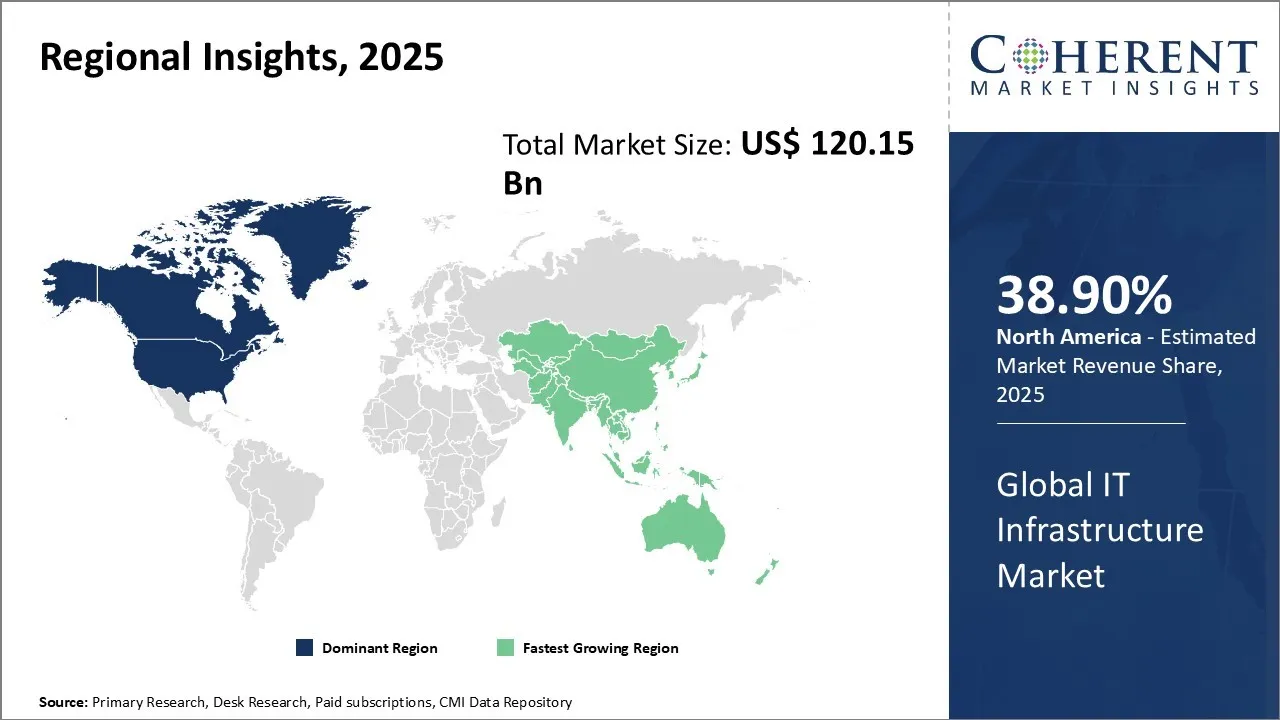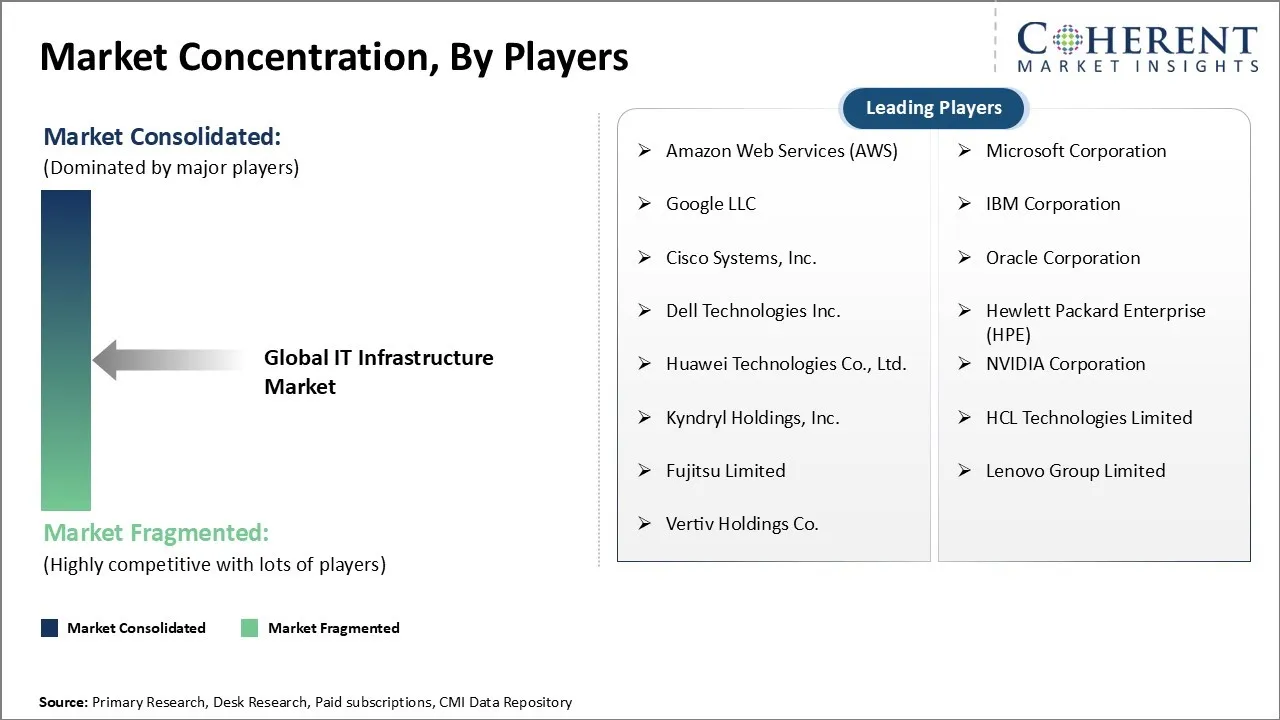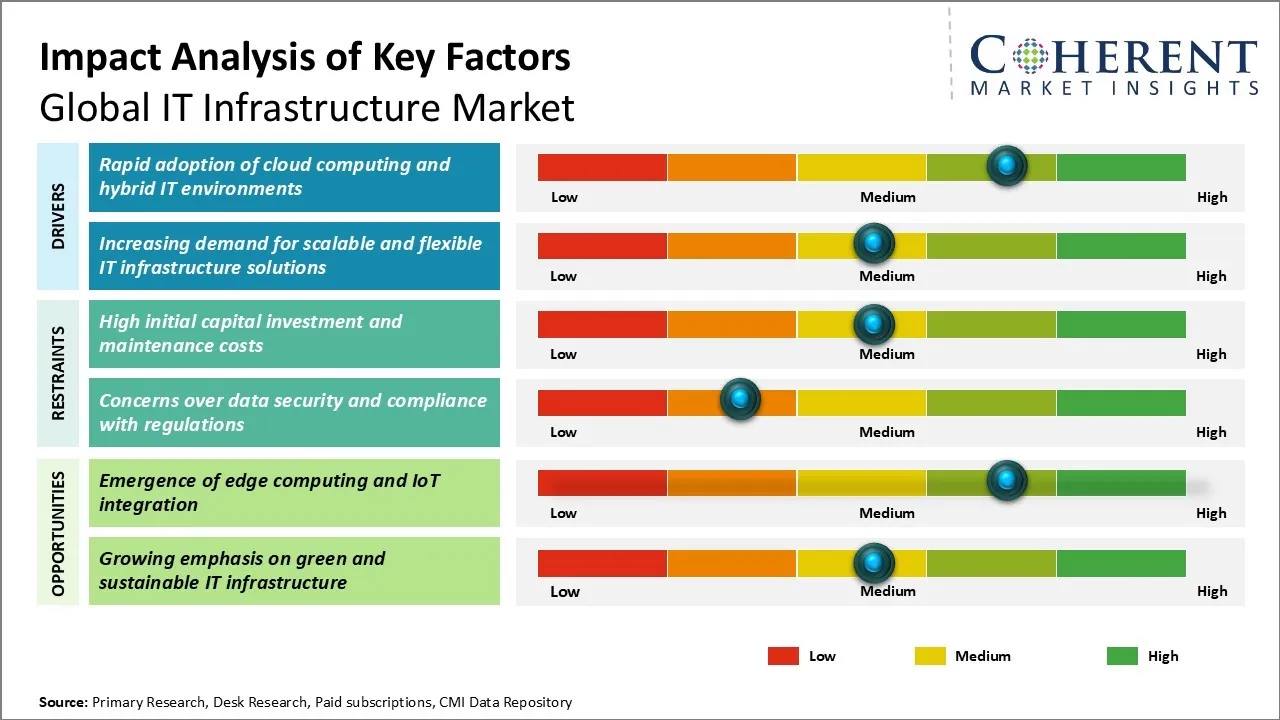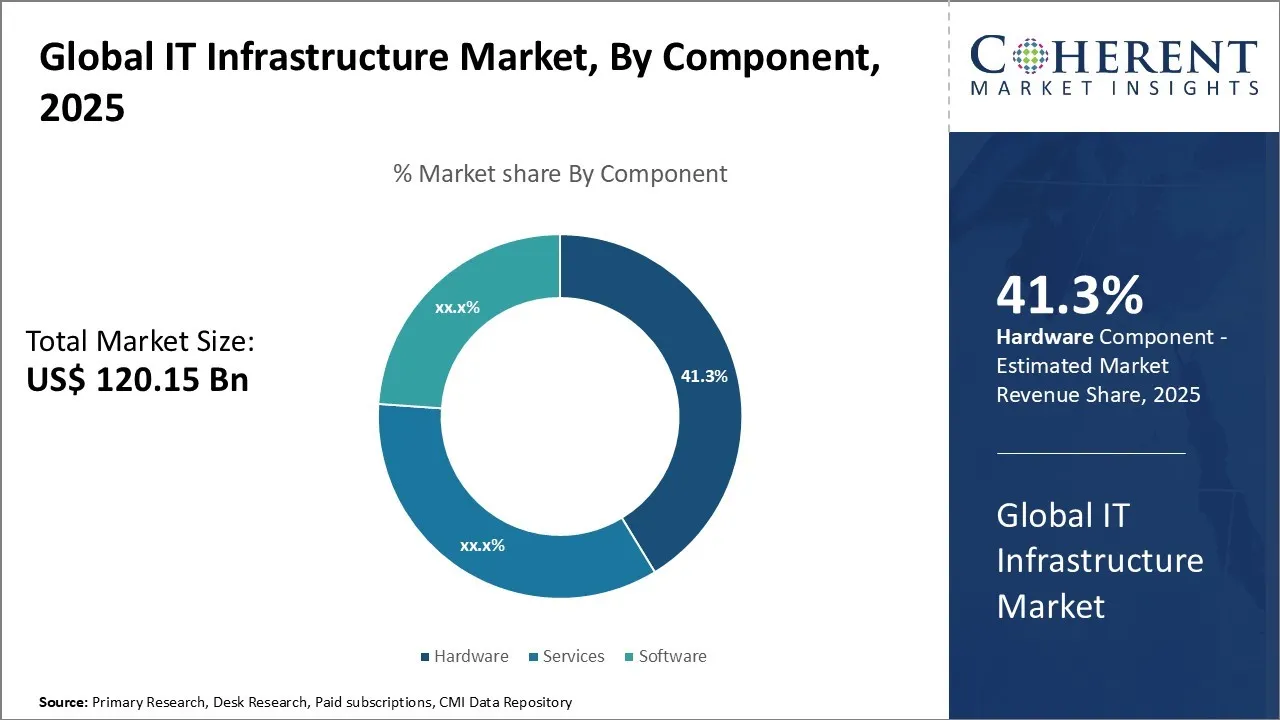IT Infrastructure Market Size and Forecast – 2025-2032
The Global IT Infrastructure Market is expected to be valued at US$ 120.15 billion in 2025 and reach US$ 241.69 billion by 2032, exhibiting a compound annual growth rate (CAGR) of 10.5% from 2025 to 2032.
Key Takeaways of the Global IT Infrastructure Market:
- The hardware segment is expected to lead the market holding a share of 41.3% in 2025, owing to continuous technological advancements and upgrades.
- The on-premise segment is projected to dominate with a share of 58.7% in 2025, owing to critical security and compliance requirements in some industries.
- North America is estimated to lead the market with a share of 38.9% in 2025, owing to the region’s highly developed IT sector. Asia Pacific, holding a share of 30.6% in 2025, is projected to be the fastest growing region, owing to growing internet penetration and digitalization.
Market Overview:
The global IT infrastructure market is seeing strong growth, driven by the rapid adoption of digital technologies and the ongoing shift to cloud-based solutions. Businesses across all industries are stepping up their investments to create a scalable, secure, and resilient infrastructure, aiming to power data-driven operations, boost productivity, and support digital transformation efforts.
An example is Volkswagen Group's partnership with Amazon Web Services (AWS). Together, these companies have created Volkswagen Industrial Cloud—a scalable platform linking more than 120 factories worldwide. This setup enables real-time data analytics, predictive maintenance, and smoother operations across the company’s global manufacturing network.
Current Events and Its Impact
|
Current Events |
Description and its impact |
|
Geopolitical Tensions Reshaping Regional Infrastructure Landscapes |
|
|
Cybersecurity Regulation Overhaul Driving Compliance Costs |
|
Uncover macros and micros vetted on 75+ parameters: Get instant access to report
IT Infrastructure Market Insights by Component: Hardware acts as the backbone of digital transformation efforts
In 2025, the hardware segment is projected to hold the largest share of the IT infrastructure market— 41.3%. This growth is fueled by ongoing technological advancements and the constant need for hardware upgrades across industries. With more business processes moving online and data volumes skyrocketing, the demand for high-performance servers, storage systems, and networking gear is only going up. Technologies like AI, IoT, big data, and cloud computing all rely heavily on powerful hardware to function—handling everything from data collection to storage and analysis.
For instance, Meta (formerly Facebook) announced plans to build massive next-generation data centers equipped with custom AI-optimized hardware to support metaverse and generative AI applications, illustrating how hardware investment underpins large-scale digital innovation.
IT Infrastructure Market Insights by Deployment: On-premise Infrastructure Leads Due to Reliability
The On-Premise segment is expected to contribute the highest share of 58.7% in the market in 2025 owing to critical security and compliance requirements of numerous industries. Several organizations in sectors like healthcare, financial services, defense, etc. are bound by stringent data governance norms that necessitate retaining core applications and sensitive information within secured internal servers.
While cloud deployment provides scalability and cost benefits, regulatory restrictions along with concern over potential data breaches drive many to choose private infrastructure under their direct control. For mission critical functions, guaranteed accessibility and minimal downtime take precedence over public cloud flexibility. As technological risks and cyber threats continue evolving, maintaining full control of infrastructure will stay an imperative for data sensitive industries.
For example, Bank of America continues to operate a hybrid strategy but heavily relies on its on-premise private cloud, developed in-house, to manage sensitive customer data and financial transactions while complying with global data security regulations.
Role of Artificial Intelligence (AI)
Artificial Intelligence (AI) is playing a transformative role in reshaping modern IT infrastructure. From intelligent automation to predictive maintenance and real-time threat detection, AI is helping organizations make their infrastructure smarter, more efficient, and more responsive.
AI is also driving major advances in data center automation and cloud resource management. By improving how resources are allocated and scaled, AI makes infrastructure more agile and cost-effective—key factors for businesses under pressure to innovate quickly.
A notable example of this came in March 2024, when NVIDIA and Equinix partnered to launch AI-powered Infrastructure-as-a-Service (IaaS) within Equinix’s global data centers. This aims to give enterprises on-demand access to high-performance GPU clusters built specifically for AI and machine learning workloads. It is a strong signal of how AI is becoming foundational to the future of IT infrastructure.
Regional Insights

Need a Different Region or Segment? Download Free Sample
North America IT Infrastructure Market Analysis and Trends
North America, holding a share of 38.9% in 2025, is expected to dominate the IT infrastructure market owing to the strong presence of key technological players and a favorable market ecosystem in the region. Countries like the U.S. and Canada have a highly developed IT sector with robust investment in R&D. Major companies such as HP, Dell, IBM, and Cisco have their headquarters in North America and contribute tremendously to the regional market growth.
Asia Pacific IT Infrastructure Market Analysis and Trends
The Asia Pacific region, holding a share of 30.6% in 2025, is expected to exhibit the fastest growth riding on increasing digitization, growing internet penetration, and massive investments by both public and private enterprises in the IT infrastructure. Countries like China, India, and Japan house a large pool of technical workforce and are emerging as global manufacturing hubs for IT products. This has created a fertile ground for the expansion of players like Huawei, Lenovo, and Samsung.
IT Infrastructure Market Outlook for Key Countries
U.S. IT Infrastructure Market Analysis and Trends
The U.S. IT infrastructure market continues to be a front-runner driven by increasing demand for scalable and efficient computing. Companies are rapidly deploying the latest technologies like cloud, IoT and edge computing. Major brands, such as Cisco and IBM, are directing significant efforts towards innovation to strengthen their presence.
China IT Infrastructure Market Analysis and Trends
China IT infrastructure market is thriving on the back of widespread digitization of industries and modernization plans under the Digital Silk Road initiative. Local brands, such as Huawei, have been consolidating their position while international corporations are actively engaged in partnerships and joint ventures.
India IT Infrastructure Market Analysis and Trends
Rapid expansion of internet and smartphone users in India is powering the IT infrastructure growth. The government's Digital India program is encouraging technology assimilation across sectors. Indian companies, such as TCS and Wipro Ltd. are actively supporting this digital revolution. These firms are investing in cloud-native platforms, data center expansion, and managed services tailored to the needs of domestic and global clients.
Japan IT Infrastructure Market Analysis and Trends
Japan continues to demonstrate technological leadership in IT infrastructure, especially in sectors such as robotics, factory automation, and precision manufacturing. With strong government and private sector support, Japan is rapidly advancing in 5G deployment, AI integration, and high-performance computing. Strategic investments from firms like Hitachi and Fujitsu are also benefitting the market.
End User Feedback and Unmet Needs
End users across various industries are seeing real benefits from today’s IT infrastructure—especially with the shift toward cloud and hybrid environments. Improved speed, scalability, and flexibility are frequently cited as major wins.
However, many organizations still face challenges with integrating new systems into existing infrastructure. Complex setups, high operating costs, and limited interoperability with legacy systems continue to frustrate IT teams. There is also growing demand for infrastructure that is not only powerful, but easier to manage—particularly through more intuitive interfaces and streamlined admin tools.
Market Players, Key Devlopment, and Competitive Intelligence

Get actionable strategies to beat competition: Download Free Sample
Key Developments:
- On April 14, 2025, Nvidia, the pioneer in chipmaking, announced a push to produce NVIDIA AI supercomputers entirely in the U.S. for the first time. The company said it plans to produce up to US$ 500 billion of AI infrastructure in the U.S. via its manufacturing partnerships over the next four years.
- In June 2024, Cisco unveiled Nexus HyperFabric AI Clusters, a simplified data center solution with NVIDIA for generative AI, combining their innovations to ease AI application deployment and offer IT visibility and analytics across the infrastructure
- In January 2024, Legrand acquired ZPE Systems, enhancing its data center offerings with ZPE's high-performance automation infrastructure solutions
- In May 2023, Kyndryl Holdings Inc., a global leader in providing IT infrastructure services, and Cloudflare Inc., an IT service management company in the U.S, entered into a partnership with a view towards assisting organizations in transforming and expanding their corporate networks using managed WAN-as-a-Service in conjunction with Cloudflare Zero Trust
Top Strategies Followed by Global IT Infrastructure Market Players
- Established Players: Leading companies like Cisco, IBM, Dell Technologies, and HPE are investing in hybrid cloud platforms, next-generation data centers, and automation-driven IT ecosystems.
- IBM acquired Apptio, a technology spend management platform, to bolster hybrid cloud financial operations.
- Mid-level Players: Mid-sized firms such as Supermicro, Pure Storage, and NetApp optimize performance and pricing to cater to growing mid-market demands.
- For instance, NetApp partnered with Microsoft Azure to offer native file storage services, helping customers transition legacy workloads to the cloud.
- Pure Storage launched Evergreen//One, a flexible storage-as-a-service model, allowing mid-sized firms to scale without major capital expenses.
- Supermicro aggressively expanded in Southeast Asia and the Middle East, offering cost-optimized server and storage infrastructure for regional cloud and AI projects.
- Small-scale Players: Smaller players differentiate through specialization in niche markets, vertical-specific infrastructure solutions, and customer-focused innovations. They often serve SMEs, edge computing deployments, or emerging tech needs (e.g., Blockchain infrastructure, AI edge appliances).
- For example, Scale Computing offers hyperconverged infrastructure tailored for edge computing, supporting industries like retail and manufacturing.
Market Report Scope
IT Infrastructure Market Report Coverage
| Report Coverage | Details | ||
|---|---|---|---|
| Base Year: | 2024 | Market Size in 2025: | USD 120.15 Bn |
| Historical Data for: | 2020 To 2024 | Forecast Period: | 2025 To 2032 |
| Forecast Period 2025 to 2032 CAGR: | 10.5% | 2032 Value Projection: | USD 241.69 Bn |
| Geographies covered: |
|
||
| Segments covered: |
|
||
| Companies covered: |
Amazon Web Services (AWS), Microsoft Corporation, Google LLC, IBM Corporation, Cisco Systems, Inc., Oracle Corporation, Dell Technologies Inc., Hewlett Packard Enterprise (HPE), Huawei Technologies Co., Ltd., NVIDIA Corporation, Kyndryl Holdings, Inc., HCL Technologies Limited, Fujitsu Limited, Lenovo Group Limited, and Vertiv Holdings Co. |
||
| Growth Drivers: |
|
||
| Restraints & Challenges: |
|
||
Uncover macros and micros vetted on 75+ parameters: Get instant access to report
Market Dynamics

Discover market dynamics shaping the industry: Download Free Sample
Global IT Infrastructure Market Driver - Rapid adoption of cloud computing and hybrid IT environments
The rapid adoption of cloud computing and hybrid IT environments across organizations is projected to be a major driver for the global IT infrastructure market during the forecast period. With workforces becoming increasingly distributed as flexible and remote working arrangements become more common, businesses are adopting cloud-based solutions and hybrid IT models at a fast pace to enable greater workforce productivity and business continuity. This shift towards cloud and hybrid IT is propelling greater investments in IT infrastructure such as servers, storage, and networking solutions that can handle dynamic workloads and support a combination of on-premises and public/private cloud environments.
For instance, HSBC adopted a hybrid cloud strategy by partnering with Google Cloud and Oracle, enabling the global bank to modernize its core systems, improve customer service, and increase infrastructure flexibility while maintaining control over mission-critical workloads hosted on-premises.
Global IT Infrastructure Market Opportunity – Emergence of edge computing and IoT integration
The proliferation of connected devices and sensors generating data at the edge is driving the need to deploy computing and storage resources closer to where data is created. This popularity of edge computing is opening up opportunities for IT infrastructure providers to collaborate with telecom and network equipment providers to setup more decentralized micro data centers, distribution nodes and edge aggregations points.
For example, Microsoft partnered with AT&T to deliver edge computing solutions by integrating Azure services with AT&T’s 5G infrastructure, enabling ultra-low latency use cases like industrial automation, smart cities, and connected vehicles.
Analyst Opinion (Expert Opinion)
- One of the most key developments is the rise of Software-Defined Infrastructure (SDI). This technology is giving businesses the ability to respond to change with speed and precision. In the digital world, where downtime is unacceptable and customer expectations are sky-high, agility is not a luxury but a necessity.
- Infrastructure innovation cannot just be about speed and scale anymore. Vendors that bake in intelligence, sustainability, and security from the start are the ones that will pull ahead. Green data centers are now becoming a baseline expectation. Enterprises want infrastructure that can auto-scale during traffic spikes, shut down idle resources to save energy, and enforce zero-trust security policies without manual oversight.
Market Segmentation
- Component Insights (Revenue, US$ Bn, 2020 - 2032)
-
- Hardware
- Services
- Software
- Deployment Insights (Revenue, US$ Bn, 2020 - 2032)
-
- On-premise
- Cloud-based
- Regional Insights (Revenue, US$ Bn, 2020 - 2032)
- North America
- U.S.
- Canada
- Latin America
- Brazil
- Argentina
- Mexico
- Rest of Latin America
- Europe
- Germany
- U.K.
- Spain
- France
- Italy
- Russia
- Rest of Europe
- Asia Pacific
- China
- India
- Japan
- Australia
- South Korea
- ASEAN
- Rest of Asia Pacific
- Middle East
- GCC Countries
- Israel
- Rest of Middle East
- Africa
- South Africa
- North Africa
- Central Africa
- North America
- Key Players Insights
- Amazon Web Services (AWS)
- Microsoft Corporation
- Google LLC
- IBM Corporation
- Cisco Systems, Inc.
- Oracle Corporation
- Dell Technologies Inc.
- Hewlett Packard Enterprise (HPE)
- Huawei Technologies Co., Ltd.
- NVIDIA Corporation
- Kyndryl Holdings, Inc.
- HCL Technologies Limited
- Fujitsu Limited
- Lenovo Group Limited
- Vertiv Holdings Co.
Sources
Primary Research Interviews:
Stakeholders:
- CIOs and IT Directors across BFSI, Manufacturing, and Healthcare Enterprises
- IT Infrastructure Providers (e.g., HPE, Dell Technologies, Cisco Systems)
- Cloud Service Providers (e.g., Microsoft Azure, AWS, Oracle Cloud)
- Data Center Operators and Colocation Service Providers
- System Integrators and Managed Services Companies
- Network Equipment Vendors and Edge Computing Startups
- Government Officials involved in Smart Infrastructure and Digital Transformation
Databases:
- TechNova Infrastructure Intelligence Portal
- Global ICT Development Index (UN ICT Division)
- Digital Infrastructure Insights – University of London Data Lab
- Asia Pacific Digital Transformation Database (APDTD)
- InfrastructureTech Tracker by GIIA
Magazines:
- Enterprise Infrastructure Weekly
- Next-Gen Data Center Monthly
- Cloud & Compute World
- EdgeTech Review
- Digital Infrastructure Today
Journals:
- Journal of Emerging IT Systems and Infrastructure
- Global Journal of Cloud Computing & Networks
- AI-Driven Infrastructure Review
- Smart Systems & Infrastructure Engineering Journal
- IoT & Digital Infrastructure Research Letters
Newspapers:
- TechPost Global
- The Infrastructure Herald
- Digital Times (Singapore)
- BusinessLine IT Focus (India)
- Network World Daily
Associations:
- Global Data Infrastructure Alliance (GDIA)
- International Cloud Infrastructure Consortium (ICIC)
- Asia-Pacific IT Hardware Manufacturers Forum (APITHMF)
- National Association of Data Center Professionals (NADCP)
- Federation of Edge Computing Enterprises (FECE)
Public Domain Sources:
- U.S. Census Bureau
- EUROSTAT
- United Nations Economic Commission for Europe (UNECE)
- World Bank
- ResearchGate
Share
Share
About Author
Monica Shevgan has 9+ years of experience in market research and business consulting driving client-centric product delivery of the Information and Communication Technology (ICT) team, enhancing client experiences, and shaping business strategy for optimal outcomes. Passionate about client success.
Missing comfort of reading report in your local language? Find your preferred language :
Transform your Strategy with Exclusive Trending Reports :
Frequently Asked Questions
EXISTING CLIENTELE
Joining thousands of companies around the world committed to making the Excellent Business Solutions.
View All Our Clients


